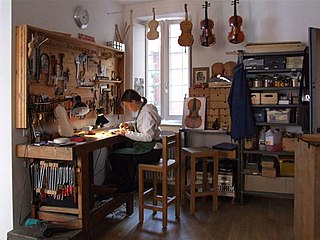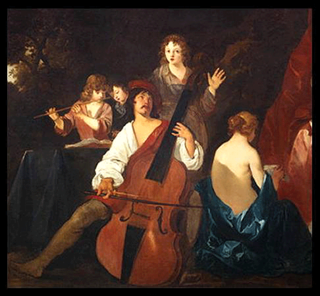
The violoncello ( VY-ə-lən-CHEL-oh, Italian pronunciation:[vjolonˈtʃɛllo]), normally simply abbreviated as cello ( CHEL-oh), is a middle pitched bowed (sometimes plucked and occasionally hit) string instrument of the violin family. Its four strings are usually tuned in perfect fifths: from low to high, C2, G2, D3 and A3. The viola's four strings are each an octave higher. Music for the cello is generally written in the bass clef, with usually, tenor clef and treble clef used for higher-range passages.

The viola da gamba, or viol, or informally gamba, is a bowed and fretted string instrument that is played da gamba. It is distinct from the later violin, or viola da braccio; and it is any one of the earlier viol family of bowed, fretted, and stringed instruments with hollow wooden bodies and pegboxes where the tension on the strings can be increased or decreased to adjust the pitch of each of the strings. Although treble, tenor and bass were most commonly used, viols came in different sizes, including pardessus, treble, alto, small tenor, tenor, bass and contrabass.

The viola d'amore is a 7- or 6-stringed musical instrument with additional sympathetic strings used chiefly in the baroque period. It is played under the chin in the same manner as the violin.

The Brandenburg Concertos by Johann Sebastian Bach are a collection of six instrumental works presented by Bach to Christian Ludwig, Margrave of Brandenburg-Schwedt, in 1721. The original French title is Six Concerts Avec plusieurs instruments, meaning "Six Concertos for several instruments". Some of the pieces feature several solo instruments in combination. They are widely regarded as some of the greatest orchestral compositions of the Baroque era.

A luthier is a craftsperson who builds or repairs string instruments.
Bowed string instruments are a subcategory of string instruments that are played by a bow rubbing the strings. The bow rubbing the string causes vibration which the instrument emits as sound.

The lirone is the bass member of the lira family of instruments that was popular in the late 16th and early 17th centuries. It is a bowed string instrument with between 9 and 16 gut strings and a fretted neck. When played, it is held between the legs in the manner of a cello or viol.

The term violone can refer to several distinct large, bowed musical instruments which belong to either the viol or violin family. The violone is sometimes a fretted instrument, and may have six, five, four, or even only three strings. The violone is also not always a contrabass instrument. In modern parlance, one usually tries to clarify the 'type' of violone by adding a qualifier based on the tuning or on geography, or by using other terms that have a more precise connotation. The term violone may be used correctly to describe many different instruments, yet distinguishing among these types can be difficult, especially for those not familiar with the historical instruments of the viol and violin families and their respective variations in tuning.

Hille Perl is a German virtuoso performer of the viola da gamba and lirone.

The violin family of musical instruments was developed in Italy in the 16th century. At the time the name of this family of instruments was viole da braccio which was used to distinguish them from the viol family. The standard modern violin family consists of the violin, viola, cello, and (possibly) double bass.

The violin, viola and cello were first built in the early 16th century, in Italy. The earliest evidence for their existence is in paintings by Gaudenzio Ferrari from the 1530s, though Ferrari's instruments had only three strings. The Académie musicale, a treatise written in 1556 by Philibert Jambe de Fer, gives a clear description of the violin family much as we know it today.

Gasparo da Salò is the name given to Gasparo Bertolotti, one of the earliest violin makers and an expert double bass player. Around 80 of his instruments are known to have survived to the present day: violins, alto and tenor violas, viols, violones and double basses, violas designed with only a pair of corners, and ceteras.
Giovanni Battista Vitali was an Italian composer and violone player.
Giovanni Benedetto Platti was born possibly 9 July 1697 in Padua, then belonging to Venice. He was an Italian Baroque composer and oboist. He died 11 January 1763 in Würzburg.
Musical instruments used in Baroque music were partly used already before, partly are still in use today, but with no technology. The movement to perform music in a historically informed way, trying to recreate the sound of the period, led to the use of historic instruments of the period and to the reconstruction of instruments.
The violetta was a 16th-century musical instrument. It is believed to have been similar to a violin, but occasionally had only three strings, particularly before the 17th century. The term was later used as an umbrella for a variety of string instruments. Some of the instruments that fall under its umbrella are the viol, viola, viola bastarda, viola da braccio, viola d'amore, violetta marina, tromba marina and the viola da gamba, viola pomposa, violino piccolo, violoncello, and the violin. Many of the instruments within this family contained anywhere from three to eight strings, either had frets or did not, was built with either very narrow ribs or wide ribs, and most unique of all either did or did not contain sympathetic strings. Sympathetic strings, are strings that sit below the regular strings and vibrate, or resonate, in sympathy with the strings above them as they’re played. According to The New Grove Dictionary of Musical Instruments, one of the earliest inceptions of the term came from G.M. Lanfranco, a lesser known 16th century Italian composer, who uses the term “violetta” in one of his books titled Scintille di musica in 1533.

The violoncello da spalla, known informally as the cello da spalla, is a small cello played braced against the shoulder.

The Paris quartets is a collective designation for two sets of Chamber music compositions, each consisting of six works for flute, violin, viola da gamba, and continuo, by Georg Philipp Telemann, first published in 1730 and 1738, respectively. Telemann called his two collections Quadri and Nouveaux Quatuors. The collective designation "Paris quartets" was only first bestowed upon them in the second half of the twentieth century by the editors of the Telemann Musikalische Werke, because of their association with Telemann's celebrity visit to Paris in 1737–38. They bear the numbers 43:D1, 43:D3, 43:e1, 43:e4, 43:G1, 43:G4, 43:g1, 43:A1, 43:A3, 43:a2, 43:h1, 43:h2 in the TWV.

Viola da braccio is a term variously applied during the baroque period to instruments of the violin family, in distinction to the viola da gamba and the viol family to which the latter belongs. At first "da braccio" seems to encompass the entire violin family. Monteverdi's Orfeo designates an entire six-part string section "viole da brazzo", apparently including bass instruments held between the knees like the cello and bass violin. His Selva morale (1641) contains a piece calling for "due violini & 3 viole da brazzo ouero 3 Tronboni", reflecting a general shift in meaning towards the lower instruments. Eventually it came to be reserved for the alto member, the viola. A famous example is Bach's Sixth Brandenburg Concerto (1721), combining two viole da braccio with two viole da gamba. The German word for viola, Bratsche, is a relic of this last use.













